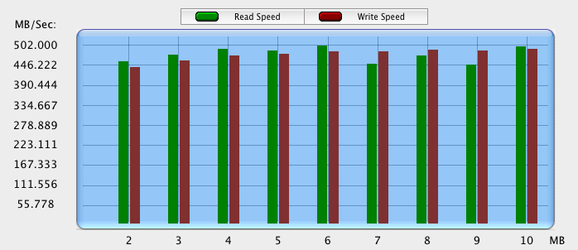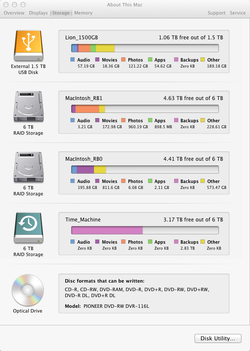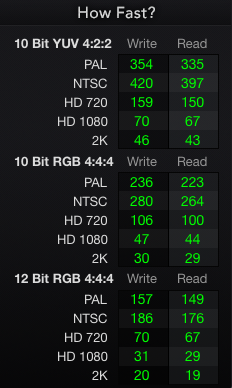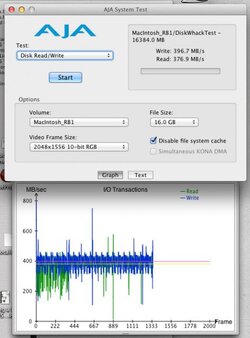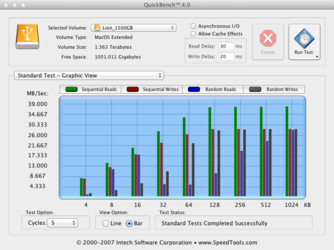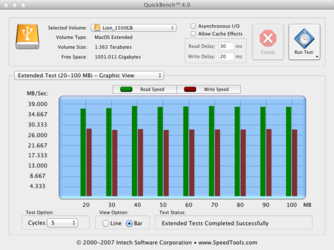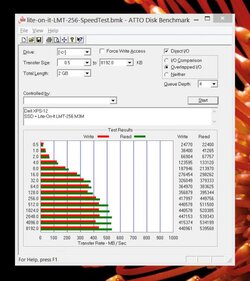Tesselator
New Member
- Joined
- Feb 16, 2013
- Location
- Japan
Tip #: 001
Requirements:
Mac computer running OS X, 4GB of RAM or more.
Here's one I discovered. I was researching some ways to optimize my system for photo editing and web browsing (which is about all I do with my system these days - being retired and all) when I came across an article by Perry Metzger written on Apr 3, 2012. The article outlined how to turn off OS X Lion's dynamic paging MMU system. I thought whack at first but I have 32GB of ram and haven't ran out or even neared the top for months so I decided to give it a try. The commands to do this are:
I don't recommend doing this with only 8GB or less however. But if you have 24GB or more then I feel comfortable recommending running your machine full-time with the dynamic pager turned off. 16GB would probably be OK too. It works on my older 12GB mac pro system just fine. This is why "with lots of RAM" is in the title. Furthermore you should probably run some kind of memory monitor in the BG. I've been using MenuMeters since, like, forever... so I didn't need to add anything to the installation.
I guess this will help with all versions of OS X from about 10.5 on up - which is when the paging system in OS X became slightly ridiculous. Give it a try and let us know after a few days of use, what you think.
Someone mentioned on another site that this is potentially dangerous in low memory conditions so I gave that a test and here are my results:
I loaded PS and upsized a two layer image file to 2,800 megapixels. It was noticeably faster than usual. Maybe 3 or 4 times faster. Odd that - I dunno why. I guess it has something to do with the continuity of RAM with that dynamic pager turned off but that's only a guess.

And loaded a bunch of heavy-ish apps:

I then loaded "Hardware Monitor", set up a panel just monitoring Free Memory and started quitting applications. I waited a little bit to let things settle down although there were no signs that anything needed settling which is HIGHLY unusual for OS X (!!!) and looked at the VM profile that Menumeters shows:

Then I came here to write this and of this moment there is a tad over 4GB of RAM being used (Safari is being used (reopened) with those same 20 tabs open - and iTunes is still going because I dig this song too much to quit it). When OS X first starts up with everything I have added on it occupies about 3GB of RAM. And now any one of the apps or windows I just had opened will open instantly. I tried PS it took 4 seconds to load. I tried the finder window showing 1,068 images and all the icons were already rendered - the window expanded into view with the icons in place and the entire set of 1,068 images were all still cached.
And I should add that browsing and clicking around in the finder windows is suuuuper smooth right now. Normally had I done something like the above I would be making coffee waiting for the system to stabilize and hoping it didn't crash.
You can try this tip with less than 16GB if you like. It won't hurt anything. Just don't get too involved in a work project until after you have tested out the system with this modification in place to make sure it will be stable for you. I was originally writing "16GB or more" in the requirements up top until I read on the Onyx developer's site that they do something kinda similar with their tool and prescribe doing so to users with as little as 4GB.
Requirements:
Mac computer running OS X, 4GB of RAM or more.
Here's one I discovered. I was researching some ways to optimize my system for photo editing and web browsing (which is about all I do with my system these days - being retired and all) when I came across an article by Perry Metzger written on Apr 3, 2012. The article outlined how to turn off OS X Lion's dynamic paging MMU system. I thought whack at first but I have 32GB of ram and haven't ran out or even neared the top for months so I decided to give it a try. The commands to do this are:
sudo launchctl unload -w /System/Library/LaunchDaemons/com.apple.dynamic_pager.plist
followed by a reboot. And you can turn it on again with:
sudo launchctl load -wF /System/Library/LaunchDaemons/com.apple.dynamic_pager.plist
I notice SIGNIFICANTLY less drive chatter and many many operations are noticeably faster. Especially OS operations like browsing around in folders with hundreds or thousands of images in each. Icons once displayed are actually instant... I don't mean fast either. On my system they were fast before. This is instant. Poof! A maximized window populated with any sized icons of RAW (or any kind of) images just appears and scrolling to the bottom of multiple folders each containing 4,000+ images works the same way. Browsing images in LR was sped up by about 10 or 20% too. Good news for those who like LR. Bridge was already very fast (about 6 to 8 times faster than LR) for poking around in image folders but it too became slightly faster. It's too fast in the first place to measure proper differences but doing the best I could with my stop-watch it's about double the speed with 1st time page displays (from about 2s to about 1s) and instant every time after that - for hours and hours and hours... and hours...followed by a reboot. And you can turn it on again with:
sudo launchctl load -wF /System/Library/LaunchDaemons/com.apple.dynamic_pager.plist
I don't recommend doing this with only 8GB or less however. But if you have 24GB or more then I feel comfortable recommending running your machine full-time with the dynamic pager turned off. 16GB would probably be OK too. It works on my older 12GB mac pro system just fine. This is why "with lots of RAM" is in the title. Furthermore you should probably run some kind of memory monitor in the BG. I've been using MenuMeters since, like, forever... so I didn't need to add anything to the installation.
I guess this will help with all versions of OS X from about 10.5 on up - which is when the paging system in OS X became slightly ridiculous. Give it a try and let us know after a few days of use, what you think.
Someone mentioned on another site that this is potentially dangerous in low memory conditions so I gave that a test and here are my results:
I loaded PS and upsized a two layer image file to 2,800 megapixels. It was noticeably faster than usual. Maybe 3 or 4 times faster. Odd that - I dunno why. I guess it has something to do with the continuity of RAM with that dynamic pager turned off but that's only a guess.

And loaded a bunch of heavy-ish apps:

PS: 2 layer 2,800 megapixel image opened,
Safari: about 20 tabs opened with several on image threads and one (displayed) with about 120 images in it,
iTunes: 2739 albums displayed and all icons cached,
Mail: with over 1 million messages in the displayed DB,
6 Finder windows each displaying cached icons for over 400 images (plus sidecars) each - all cached,
Adobe Bridge: displaying 1,068 images,
iPhoto: Displaying the mouse-over icon anims for about 180 albums.
LR 4 (newest update): In develop mode pointed to a library of about 600 images,
And Dashboard switched to with all those little applets loaded (about 16).
Safari: about 20 tabs opened with several on image threads and one (displayed) with about 120 images in it,
iTunes: 2739 albums displayed and all icons cached,
Mail: with over 1 million messages in the displayed DB,
6 Finder windows each displaying cached icons for over 400 images (plus sidecars) each - all cached,
Adobe Bridge: displaying 1,068 images,
iPhoto: Displaying the mouse-over icon anims for about 180 albums.
LR 4 (newest update): In develop mode pointed to a library of about 600 images,
And Dashboard switched to with all those little applets loaded (about 16).
I then loaded "Hardware Monitor", set up a panel just monitoring Free Memory and started quitting applications. I waited a little bit to let things settle down although there were no signs that anything needed settling which is HIGHLY unusual for OS X (!!!) and looked at the VM profile that Menumeters shows:

Then I came here to write this and of this moment there is a tad over 4GB of RAM being used (Safari is being used (reopened) with those same 20 tabs open - and iTunes is still going because I dig this song too much to quit it). When OS X first starts up with everything I have added on it occupies about 3GB of RAM. And now any one of the apps or windows I just had opened will open instantly. I tried PS it took 4 seconds to load. I tried the finder window showing 1,068 images and all the icons were already rendered - the window expanded into view with the icons in place and the entire set of 1,068 images were all still cached.
And I should add that browsing and clicking around in the finder windows is suuuuper smooth right now. Normally had I done something like the above I would be making coffee waiting for the system to stabilize and hoping it didn't crash.
You can try this tip with less than 16GB if you like. It won't hurt anything. Just don't get too involved in a work project until after you have tested out the system with this modification in place to make sure it will be stable for you. I was originally writing "16GB or more" in the requirements up top until I read on the Onyx developer's site that they do something kinda similar with their tool and prescribe doing so to users with as little as 4GB.
